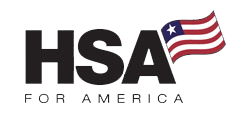Joining a medical weight loss program or simply trying to get healthier can get expensive fast.

Between gym memberships, clean eating, and structured treatment plans, the costs add up quickly. And if you’re not careful, you could end up spending thousands without seeing real results.
But you’re not alone—and you’re not without options. Understanding where your money goes and how to make the most of tax-advantaged tools like HSAs can make a big difference.
The Real Cost of Getting Healthy
Here’s what the numbers show:
- The weight loss industry was worth $163 billion in 2024 and is expected to hit $362 billion by 2034.
- Gym memberships average $55/month, or around $600/year—but can run up to nearly $2,000/year at high-end clubs.
- A fast food-based 2,000-calorie diet can cost as little as $8–$10 per day, while a balanced, nutritious 2,000-calorie diet often costs $12–$20 or more—especially if it includes fresh produce, lean proteins, or specialty items recommended in medical weight loss programs.
- Popular programs like Weight Watchers, NutriSystem, or Jenny Craig often cost well over $100 per pound lost.
When you consider these numbers—and the rising medical costs tied to obesity—it becomes clear: investing in your health is important, but you don’t have to overpay to do it. With the right strategy, you can use tax-free dollars to lower your costs and take control of your weight loss journey.
How to Save Money on Medical Weight Loss Programs
If the cost of getting healthy feels overwhelming, you’re not alone.
The good news? There’s a little-known way to cut those costs—one that most people don’t realize is even an option.
Many medical weight loss expenses are actually tax-deductible—as long as you meet a few requirements.
Now, this doesn’t include things like gym memberships or health food purchases. The IRS considers those personal expenses, not medical ones.
But here’s the key: if your weight loss program is medically necessary and prescribed by a doctor, there are several ways you can use pre-tax dollars to pay for it. And that can save you a lot—often 20% to 40% off the total cost.
The Pre-Tax Advantage: Save Money on Medically Necessary Weight Loss Treatment
Most everyday expenses come out of your after-tax income—meaning you only get to spend about 65 to 75 cents of every dollar you earn once taxes are taken out.
But when it comes to certain medical expenses, including a medical weight loss program prescribed by your doctor, there’s a smarter way to pay: using pre-tax dollars.
Here’s how it works.
If your program is medically necessary, you may be able to cover the costs through:
- A Health Savings Account (HSA)
- A Flexible Spending Account (FSA)
- The Itemized Medical Expense Deduction
Using one of these tax-advantaged tools can save you 20% to 40% on eligible costs, depending on your tax bracket and where you live.
For example, if you’re in a 25% federal tax bracket and contribute $2,000 to an HSA, you could save $500 in federal taxes alone by using that money to pay for your program.
Some states also offer extra tax breaks for HSA or FSA contributions, giving you even more savings.
Just remember: To qualify, your medical weight loss expenses must be used to treat a diagnosed medical condition—not for general fitness or appearance. Always check with your doctor and keep documentation to back it up.
How HSAs Save Thousands on Taxes and Healthcare Costs (Slideshow)
What Weight Loss Treatment Costs Can I Deduct?
Not every expense tied to weight loss will qualify for tax breaks.
Things like gym memberships, healthy groceries, or meal replacement shakes usually don’t count. The IRS sees those as personal lifestyle choices, not medical care.
To qualify for tax savings, your medical weight loss program must be prescribed by a doctor to treat a specific medical condition—like heart disease, high blood pressure, diabetes, or obesity.
In other words, general wellness or appearance goals won’t cut it.
However, if your weight is linked to a diagnosed health issue, you may be able to use your HSA, FSA, or itemized deduction to cover many related costs, including:
- Health insurance deductibles
- Health insurance copays
- Health insurance co-insurance (e.g., your 20% share in an 80/20 plan)
- Alternative therapies
- Prescription weight loss medication costs
- Physician’s consulting fees
- Counseling and therapy
- Dietician fees
- Nutritional supplements (only if prescribed to treat a specific medical condition)
- Capital expenses (e.g., modifying your home for a medical need)
- Chiropractic care
- Blood glucose test kits
- Mental healthcare related to obesity
- Weight reduction group membership fees (with a doctor’s recommendation)
- Specialist fees and consultation costs
- Bariatric surgery costs, including consultations, surgeon’s fees, anesthesia, hospital stays, and follow-ups
- Travel/transportation to receive medical care
- Lodging for yourself and a companion while receiving care
To be safe, ask your doctor for a Letter of Medical Necessity. This document confirms that your weight loss expenses are tied to a medical condition and helps ensure they’re recognized as qualified medical expenses by the IRS.
The good news? If your physician signs off, you can likely use pre-tax dollars through an HSA, FSA, or medical deduction to cover these costs.
Health Savings Accounts (HSAs) and Weight Loss Programs
A health savings account (HSA) is a tax-advantaged account you can use to pay for qualified medical expenses—including a medically necessary weight loss program—with pre-tax dollars.
If your doctor has diagnosed a medical condition like obesity, diabetes, or high blood pressure, and recommends a specific weight loss treatment, the IRS allows you to use HSA funds to cover those costs tax-free. (See IRS Publication 502 for details.)
HSAs are one of the most powerful tools in the tax code, helping millions of Americans save money on healthcare and take control of their medical expenses.
Here’s how an HSA works:
- Pre-tax contributions: You don’t pay taxes on the money you contribute to your HSA. The same goes for any contributions your employer makes on your behalf.
- Tax-deferred growth: Your HSA balance grows tax-free. That includes interest, dividends, and capital gains.
- Tax-free withdrawals: When you use the money for qualified medical expenses, you pay no taxes on withdrawals.
- Retirement bonus: After age 65, you can use HSA funds for non-medical expenses without a penalty. You’ll just pay regular income tax—similar to a traditional IRA or 401(k).
- Investment options: You can leave your HSA funds in a basic savings-style account, or invest them in stocks, mutual funds, or even real estate through a self-directed HSA provider.
And here’s the best part: You can use your HSA funds at any time, penalty-free, to pay for qualified medical weight loss programs and treatments—as long as they’re prescribed by a doctor and tied to a diagnosed medical condition.
Eligibility
To qualify for pre-tax contributions to a Health Savings Account (HSA) in 2025, you must be enrolled in a High-Deductible Health Plan (HDHP) that meets the following criteria:
- Minimum Annual Deductible:
- Self-only coverage: $1,650
- Family coverage: $3,300
- Maximum Annual Out-of-Pocket Expenses (including deductibles, copayments, and coinsurance, but excluding premiums):
- Self-only coverage: $8,300
- Family coverage: $16,600
These limits are set by the IRS for the 2025 tax year.
Enrolling in an HDHP that meets these requirements allows you to contribute to an HSA, which offers tax advantages for covering qualified medical expenses, including those related to medically necessary weight loss programs.
Compare Pricing on the Best HSA Plans Available
Flexible Spending Accounts And Weight Loss Treatment
A Flexible Spending Account (FSA) is another great way to pay for medical weight loss expenses using pre-tax dollars.
Like an HSA, an FSA lets you set aside money tax-free to cover qualified medical expenses—including a weight loss program prescribed by your doctor.
The main downside? FSAs come with a “use it or lose it” rule. Any money left in your account at the end of the year usually doesn’t carry over. If you don’t spend it, you lose it.
Still, the tax savings are similar. If you’ve been diagnosed with a condition that requires medical weight loss—like obesity, diabetes, or heart disease—you can use your FSA to pay for treatment and reduce your taxable income in the process.
Get a personalized health insurance analysis and review
How to Deduct Medical Bills on Your Income Tax Return
Don’t have an HSA or FSA? You may still be able to deduct medical weight loss expenses on your taxes—if those expenses are medically necessary and meet the IRS requirements under Publication 502.
When Weight Loss Expenses Qualify
To deduct weight loss costs, they must meet three key criteria:
- Medically Necessary: A doctor must prescribe the treatment to manage a diagnosed condition, such as obesity, diabetes, heart disease, high blood pressure, or joint/back problems.
- Qualified Medical Expense: The expense must be for prevention, diagnosis, or treatment of a medical condition—not just for general wellness or appearance.
- Unreimbursed: You can only deduct costs you paid out of pocket—not those covered by insurance or reimbursed elsewhere.
The 7.5% AGI Rule (2025)
To claim the medical expense deduction, your total eligible medical expenses must exceed 7.5% of your adjusted gross income (AGI).
Example:
If your AGI is $60,000, you can only deduct the amount of medical expenses that exceeds $4,500 (7.5% of $60,000).
Maximize Your Deduction
To get the most out of this tax benefit:
- Lower your AGI by contributing to tax-deferred accounts like:
- 401(k), 403(b), or traditional IRA
- SEP IRA (for self-employed)
- HSA or FSA (if eligible)
- Shift income and expenses between years:
- Defer income into the next tax year
- Prepay deductible business expenses or subscriptions this year
Lowering your AGI brings down the 7.5% threshold, making it easier to deduct more of your medical expenses.
2025 Standard Deduction Limits
To claim the medical expense deduction, you must itemize your deductions using Schedule A.
That means skipping the standard deduction, which in 2025 is:
- $15,000 for single filers or married filing separately
- $30,000 for married filing jointly
- $22,500 for heads of household
If your total itemized deductions (medical, mortgage interest, state/local taxes, etc.) don’t exceed your standard deduction, you’re better off taking the standard deduction instead.
A Quick Note on “Above-the-Line” Deductions
Even if you don’t itemize, you can still save money by using “above-the-line” deductions—like contributing to an HSA, FSA, or traditional IRA. These reduce your taxable income before your AGI is calculated, which helps in multiple ways, including qualifying for more itemized deductions.
Documentation and Records
To deduct medical weight loss expenses or use HSA funds without issues, you’ll need to keep good records.
What to Keep:
- A Letter of Medical Necessity from your doctor
- Receipts, invoices, and statements for all qualified expenses
- Any documentation that shows what was purchased and why it was medically necessary
You don’t need to send these documents with your tax return, but keep them on file in case the IRS ever audits you.
If You’re Using an HSA:
- Use your HSA debit card to pay for qualified weight loss treatments
- Track your spending through your HSA provider’s website or app
- At tax time, your HSA custodian will send you a tax form summarizing your qualified withdrawals
Important: Only use HSA funds for qualified medical expenses. If you spend the money on non-qualified items and you’re under age 65, you’ll owe taxes plus a 20% penalty.
What Weight Loss Expenses Don’t Qualify?
Not all weight loss expenses are eligible for tax breaks or HSA/FSA reimbursement. Here’s what typically doesn’t qualify:
General Wellness Expenses
Costs related to overall fitness or wellness—without a diagnosed medical condition—aren’t deductible. This includes general weight management efforts without a physician’s diagnosis or recommendation.
Always talk to your doctor about getting a Letter of Medical Necessity if you’re planning to use an HSA, FSA, or tax deduction for your expenses.
Gym, Spa, and Fitness Club Memberships
Gym and fitness club fees are considered personal expenses under IRS §213(d), even with a doctor’s note.
You can’t deduct them or use HSA/FSA funds to cover them. However, using pre-tax funds for qualified medical weight loss expenses might help offset the overall cost of your health and fitness routine.
Also note: If your employer pays for your gym membership, it’s usually treated as taxable income and subject to payroll taxes.
Diet Foods and Beverages
Most diet-specific foods—like low-carb snacks, shakes, or supplements—don’t qualify.
They’re seen as personal choices, not medical treatments.
The only exception is if:
- The food doesn’t meet normal nutritional needs
- It’s prescribed to treat a diagnosed medical condition
- Your doctor confirms it’s medically necessary
If all three conditions are met, then the expense may qualify.
Can You Deduct Expenses Even If You Use an HSA?
Yes. You can combine an HSA, FSA, and the medical expense deduction to maximize your savings—as long as you don’t claim the same expense more than once.
Here’s how:
- Use your HSA or FSA first to pay for qualified medical weight loss costs with pre-tax dollars
- Then, if you have unreimbursed expenses left over and your total eligible medical costs exceed 7.5% of your AGI, you can deduct the rest on Schedule A
Because your HSA contributions reduce your taxable income, they also help lower your 7.5% threshold—making it easier to deduct additional expenses.
Get Help Maximizing Your Benefits
Losing weight for medical reasons doesn’t have to break the bank. With the right strategy—and proper documentation—you can use HSAs, FSAs, and itemized deductions to cut your out-of-pocket costs by 20% to 40%.
Need help reviewing your health coverage or finding an HSA-qualified plan? Contact one of our expert Personal Benefits Managers today.
For Further Reading:
- Learn More About HSA
- How to Maximize the Value of Your HSA Account
- Turbocharge Your HSA: An Introduction to Self-Directed HSA Investing
- Up Your HSA Game With These Three Investment Strategies
Additional Resources
- IRS Publication 969 – Health Savings Accounts and Other Tax-Favored Health Plan
- IRS Publication 502 – Medical and Dental Expenses
- State Tax Treatment of HSAs
Disclaimer
HSA For America does not provide tax advice. This information is for general informational purposes only and should not be construed to be tax advice. For information specific to your situation, you should consult with a tax professional familiar with the tax laws in your specific state to understand any state-specific considerations for weight loss treatment-related expenses.

Wiley is President of HSA for America. He believes that consumers should have choice and price transparency, so they can make the best healthcare decisions for their needs. Read more about Wiley on his Bio page.



